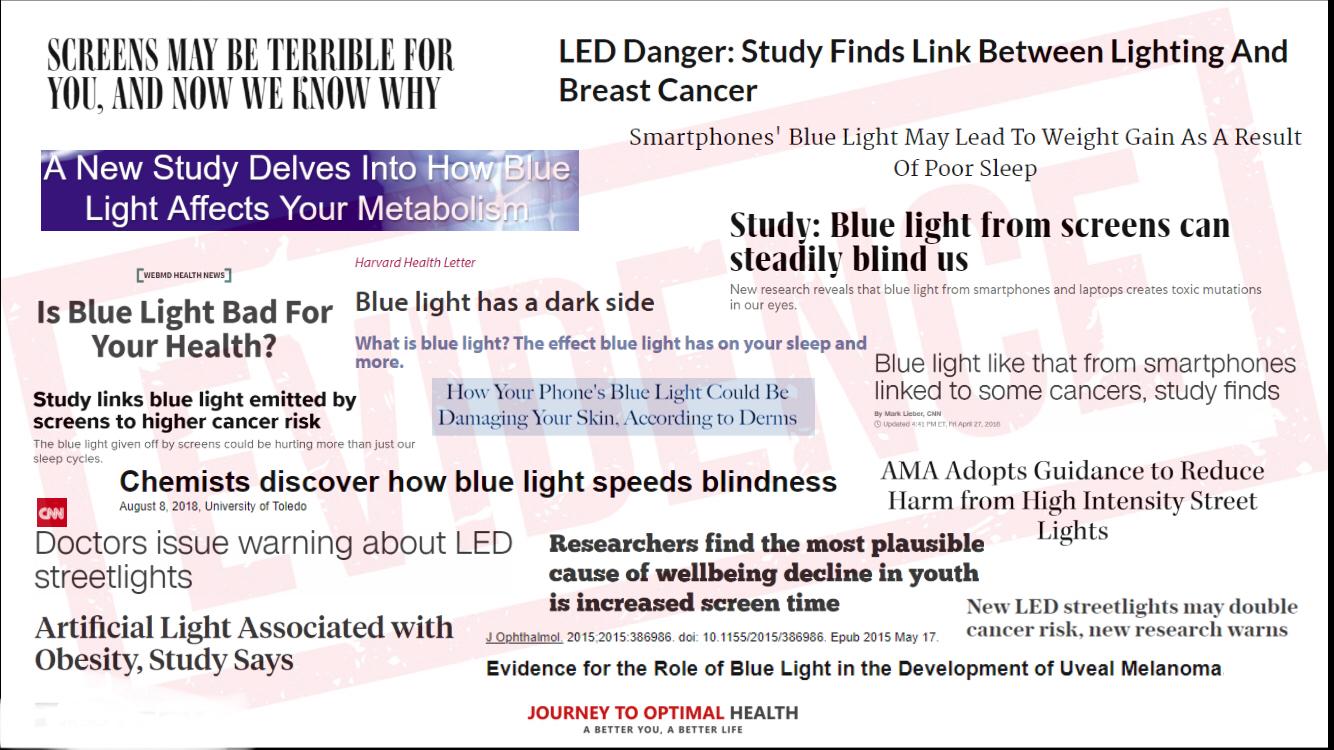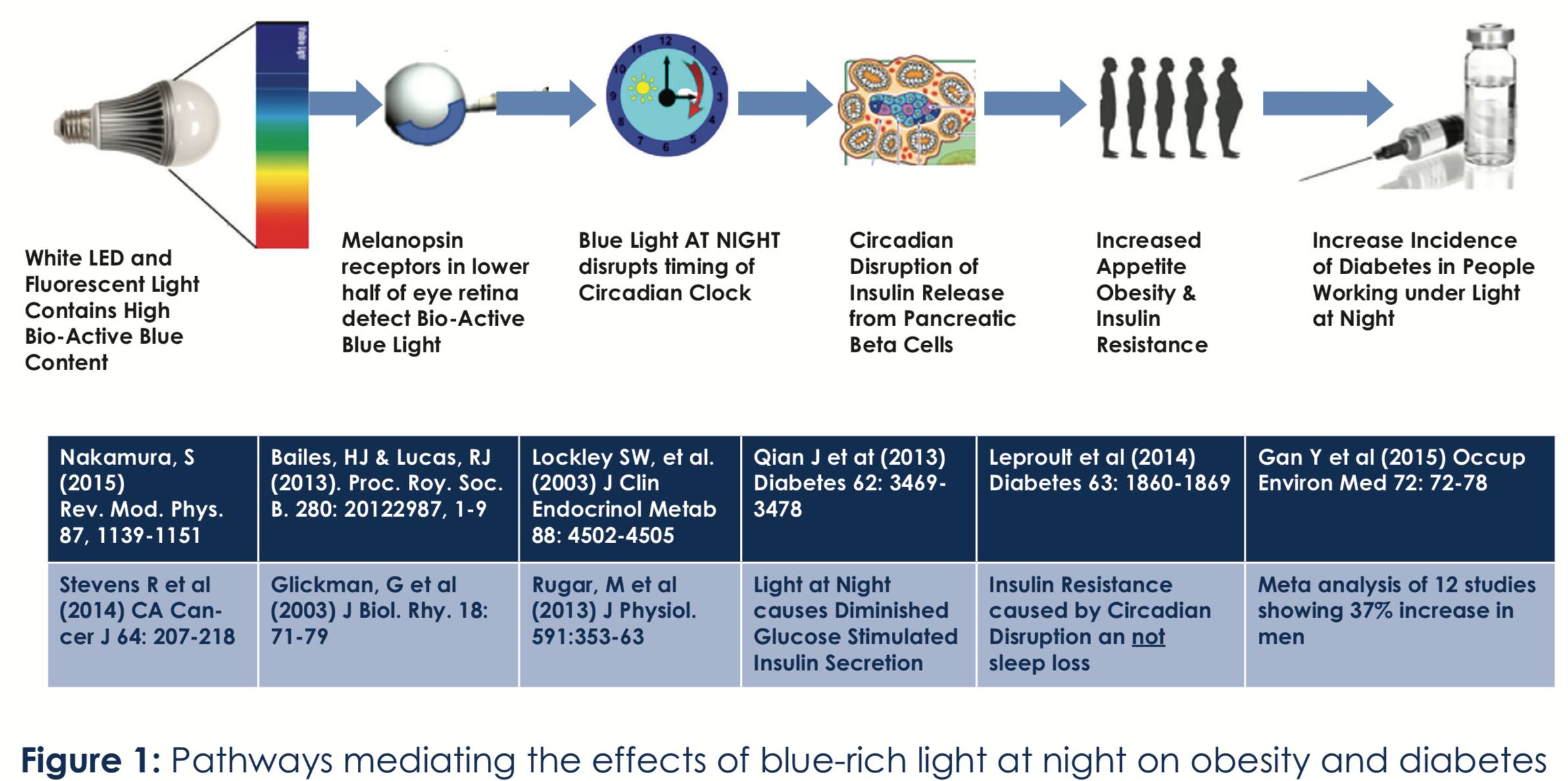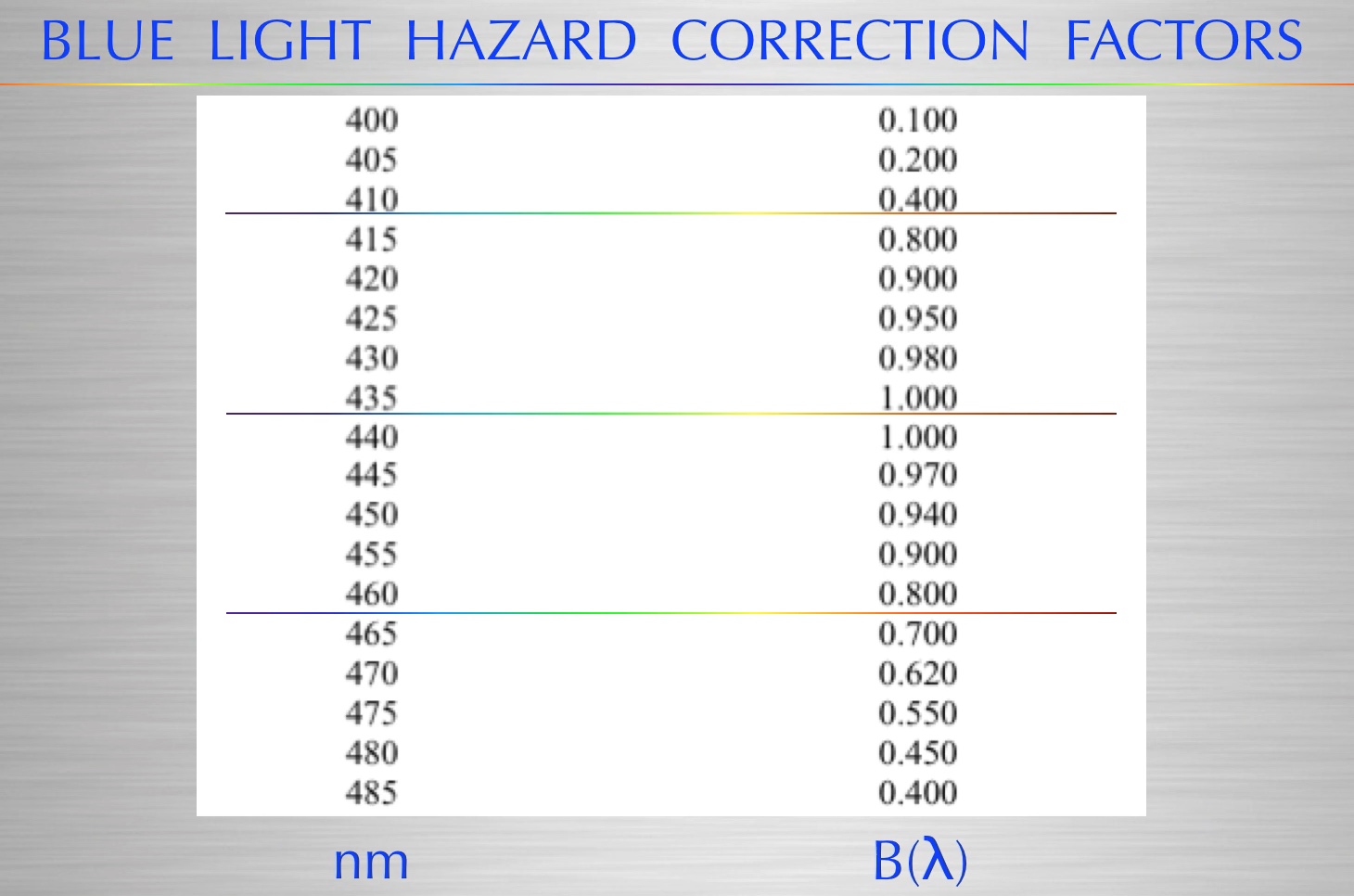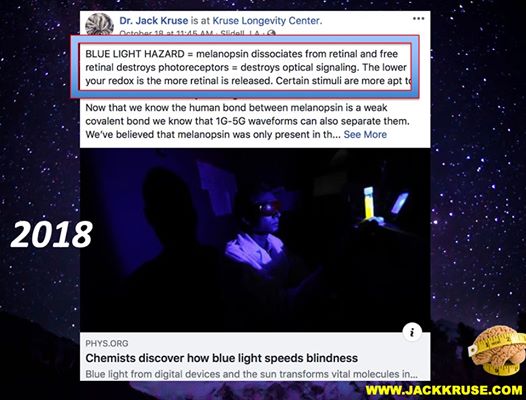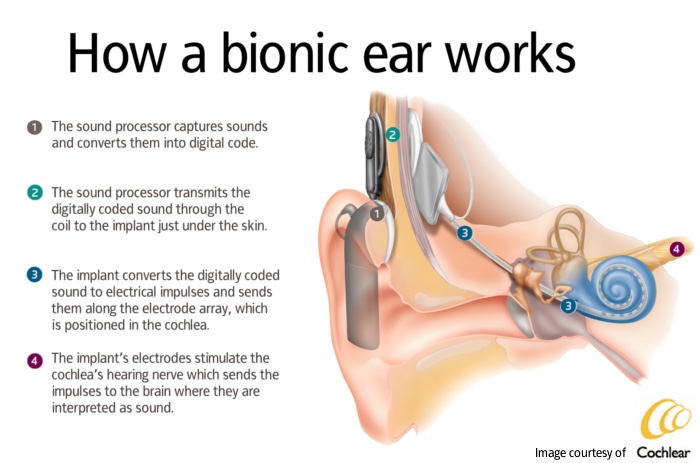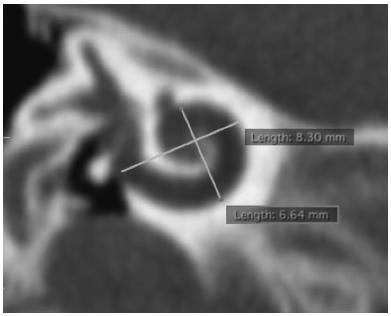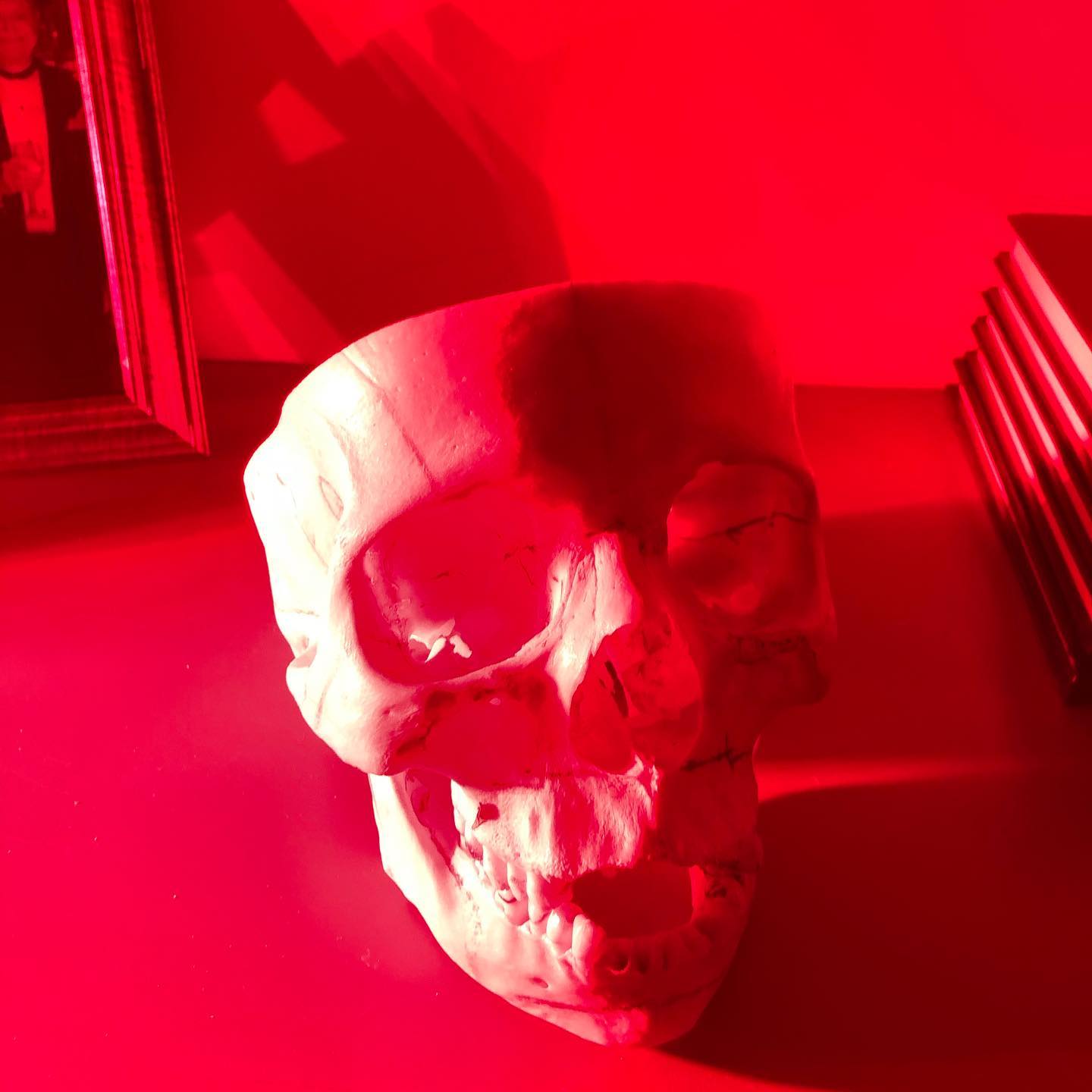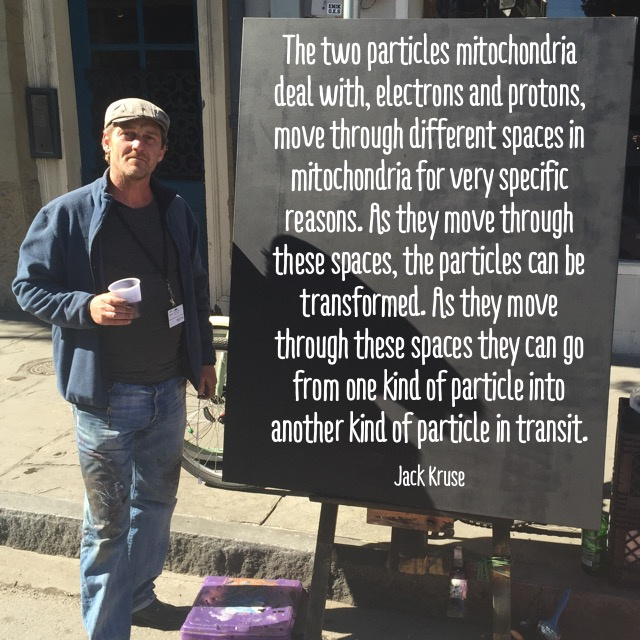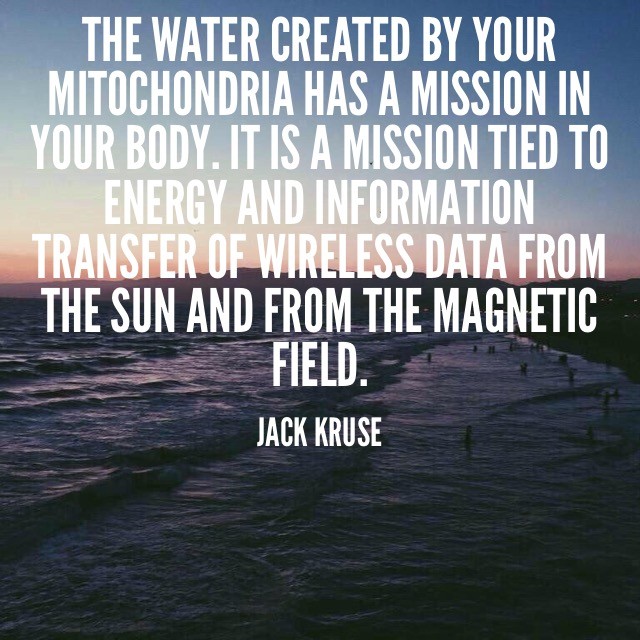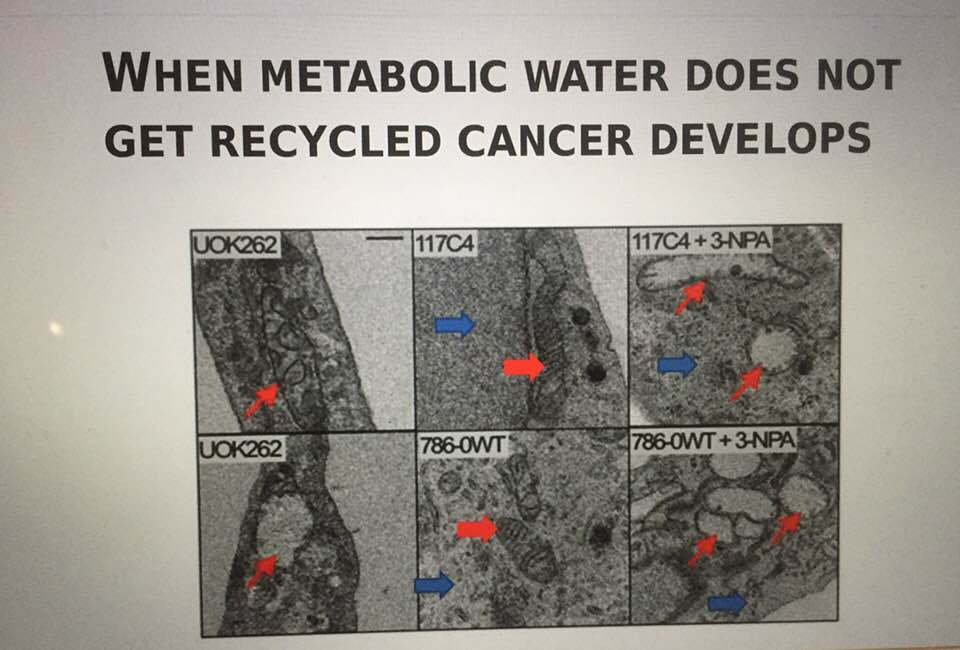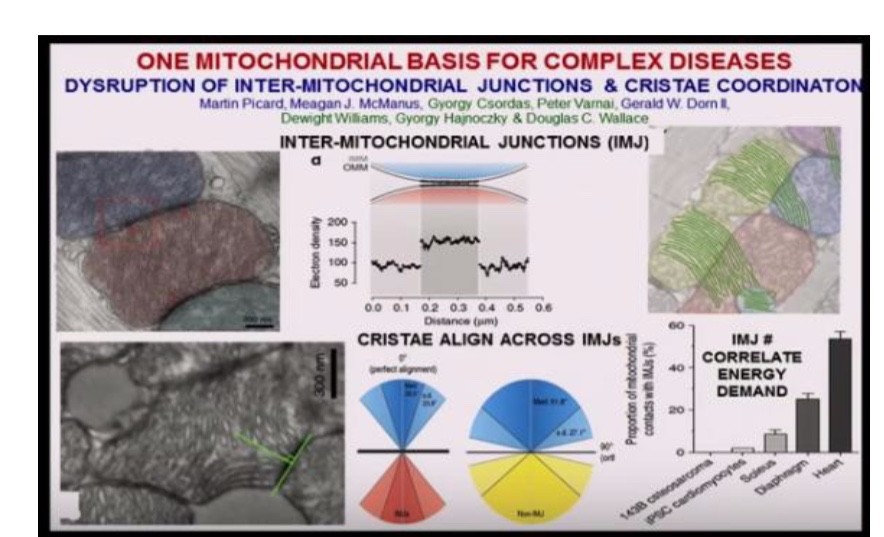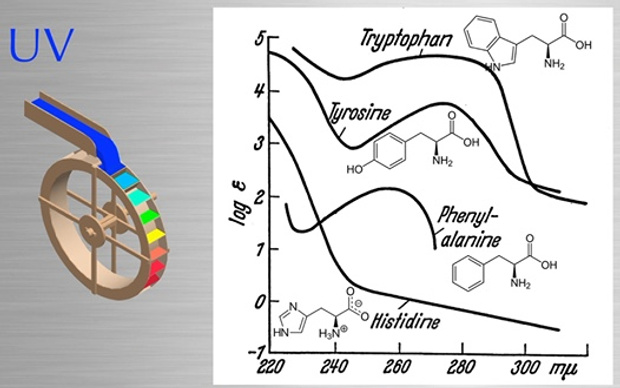
DO TINNITUS, PD, and AD all RELATE TO blue light and nnEMF via hypoxia?
In the human ear, there are melanocytes present in the hearing mechanism which are cells that form melanin. Melanin is a UV light-absorbing pigment that can be made from tyrosine or phenylalanine. You can see from the picture above that the action spectra of light from both aromatic amino acids is 220-300nm light which is deep in the UV range. This implies the light frequencies are somehow linked to how and what we hear. Tinnitus is a warning symptom that your nnEMF environment is sub-optimal. The question is for the inquiring mind, is why did evolution put this photochemical in our hearing apparatus?
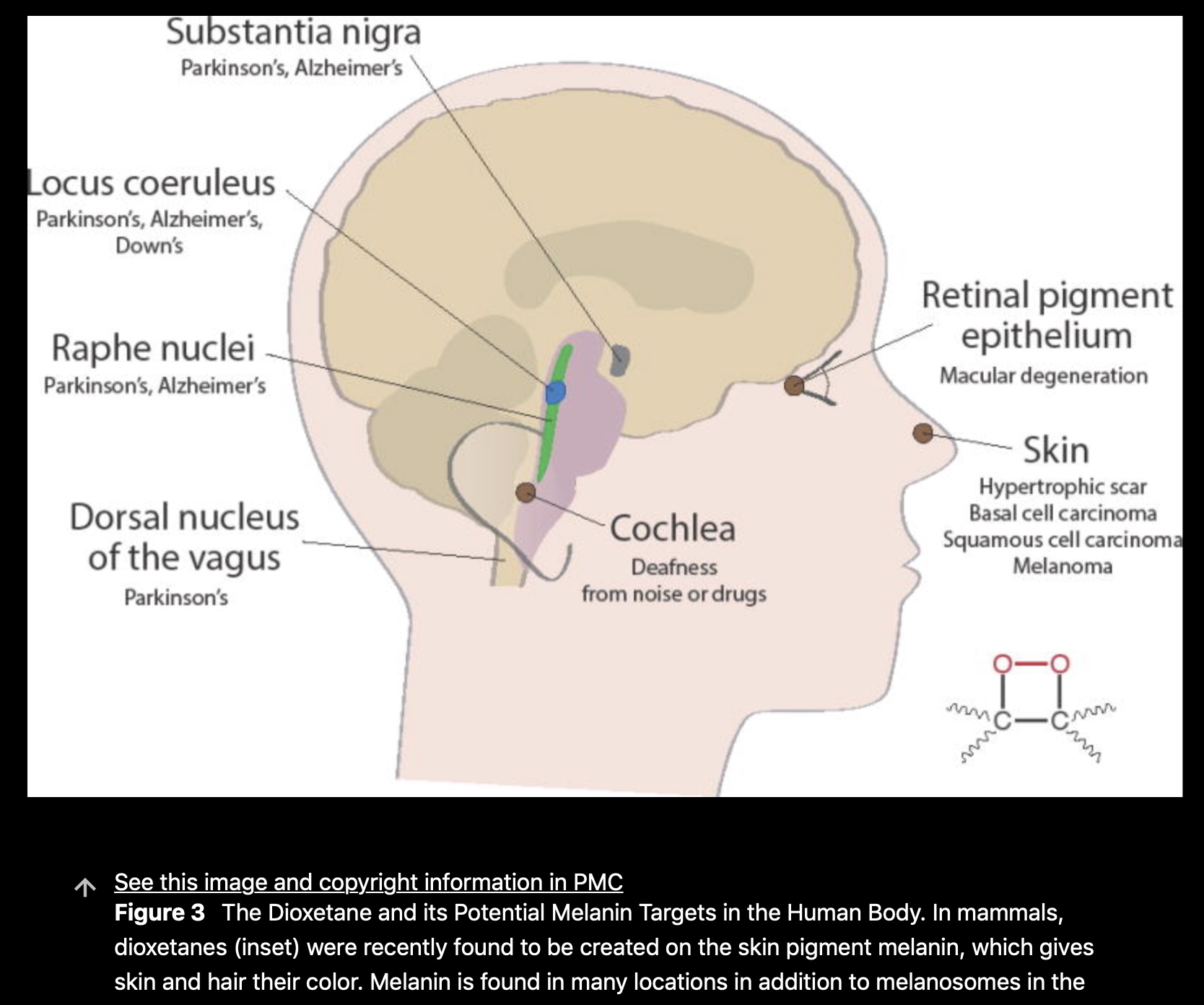
Might melanin be how we tune into our environment first before sound affects us?
Remember light travels way faster than sound so from a physics standpoint using light for the afferent sensory reflex loop makes a lot of quantum mechanical sense. It just offends your doctor’s common sense. That is a good thing for a Black Swan. We ask questions few people do.
In this system, full-spectrum solar light is critical because it contains the 200-400 nm light tyrosine/phenylalanine that needs to create melanin. Melanocytes make melanin from aromatic amino acids (tyrosine) that all have hexagonal rings of carbon that absorb UV light from 220 nm to 300 nm. For this mechanism to tune properly, you first need AM balanced light in the visible spectrum that has no UV light present. The dose of the blue light present is stimulatory to the pituitary gland but this pro-growth stimulus is always protected and balanced by the 42% of IR-A present early in the AM. The next light that shows up diurnally in solar exposure is UV-A light in the AM. when it shows up varies based upon your latitude. This explains why tinnitus is rare inside the tropics where light is more stable. I expect this will change as people inside the tropics begins to use technology from the US. This will ruin their afferent reflex loops.
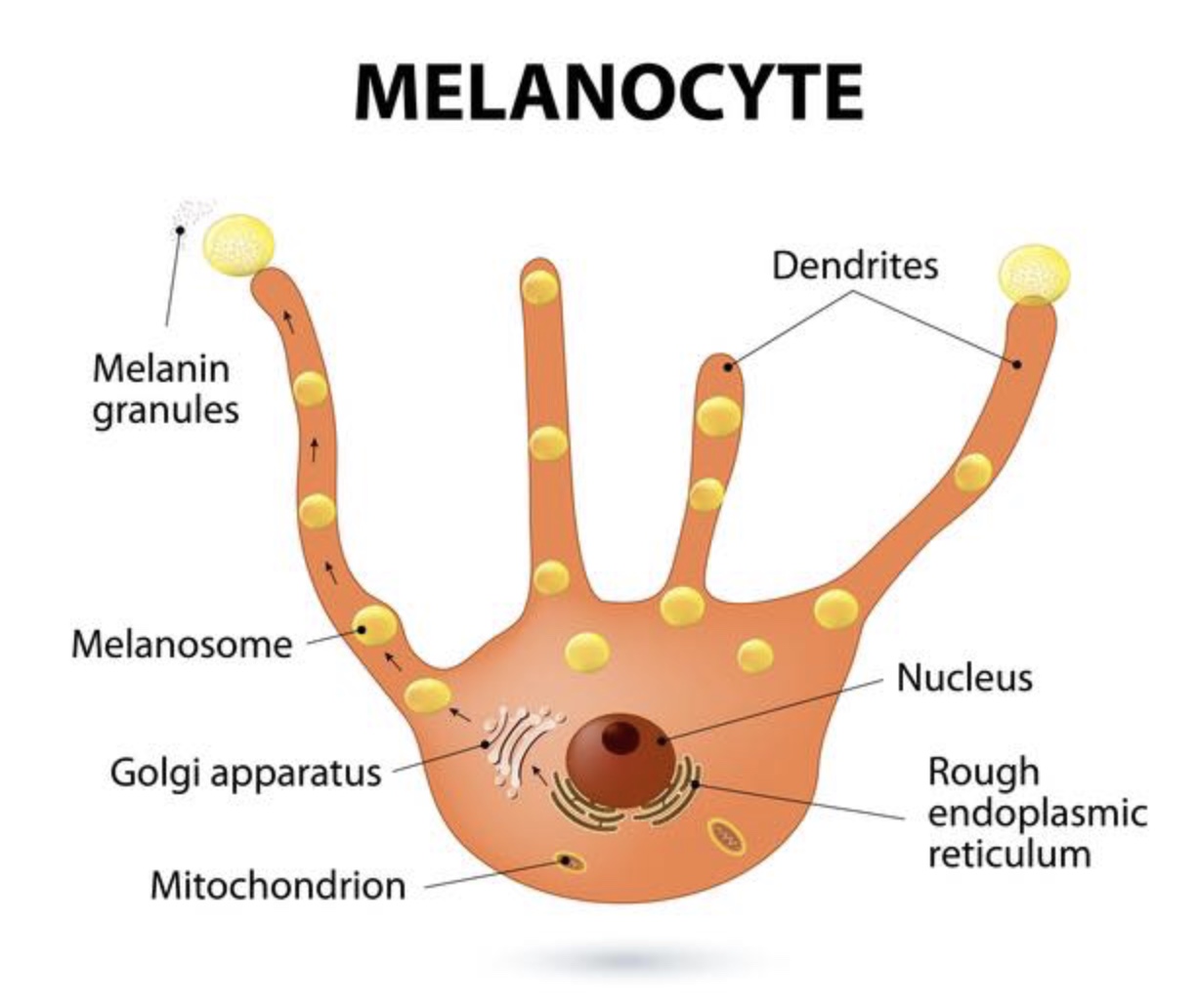
Melanosomes in the ear pay attention to UV light’s arrival by having melanin’s electrons become excited by the sun rays. To activate the system the ear pinna and external auditory canal need the full day spectrum solar light to develop naturally. This includes IR-A, UV-A, and UV-B based upon your latitude and altitude.
The human ear effectively “measures” the light radiation environment you allow via your choices and helps fine tune your hearing by reacting with the photon traps in tyrosine and phenylalanine with the formation of melanin as hearing protectors. If the radiation environment is disturbed (by man-made light), limited or no melanin is formed in the pinna or in the external auditory canal.
Without this initial stimulus, human hearing becomes affected and our hearing becomes susceptible to an improper energy transformation.
People forget that when light collides with melanin the electromagnetic wave becomes and electro-mechanical wave or an electromechanical wave called a phonon/soliton. What is the target of this phonon or soliton? Look at the picture below. Is there a pigmented vascular layer in the inner ear? Yes, there is. Why do we have light pigments in our cochlea? And why do we have melanin in our pinna and our ear canal? These are questions Black Swans ask themselves to understand why their hearing is altered.
Those phonons are targeting pigmented cells in the body of the cochlea by a process of chemiexcitation. If solar light is absent and man-made light dominant in your environment the transformation these light waves into mechanical-acoustic signals (phonons/solitons) is disturbed. This is how tinnitus begins quantum mechanically in my opinion. The afferent reflex arc is disrupted by nnEMF light waves sensed on the external ear and in our ear canals.
Melanin is a pigmented polymer with a known role in dermal solar protection. In vertebrates, melanogenesis has been reported in leukocyte population of cells suggesting a potential role in innate immunity. An altered innate immune response is one of the first things ENT surgeons should suspect in people with tinnitus but few do because they do not know about this link.
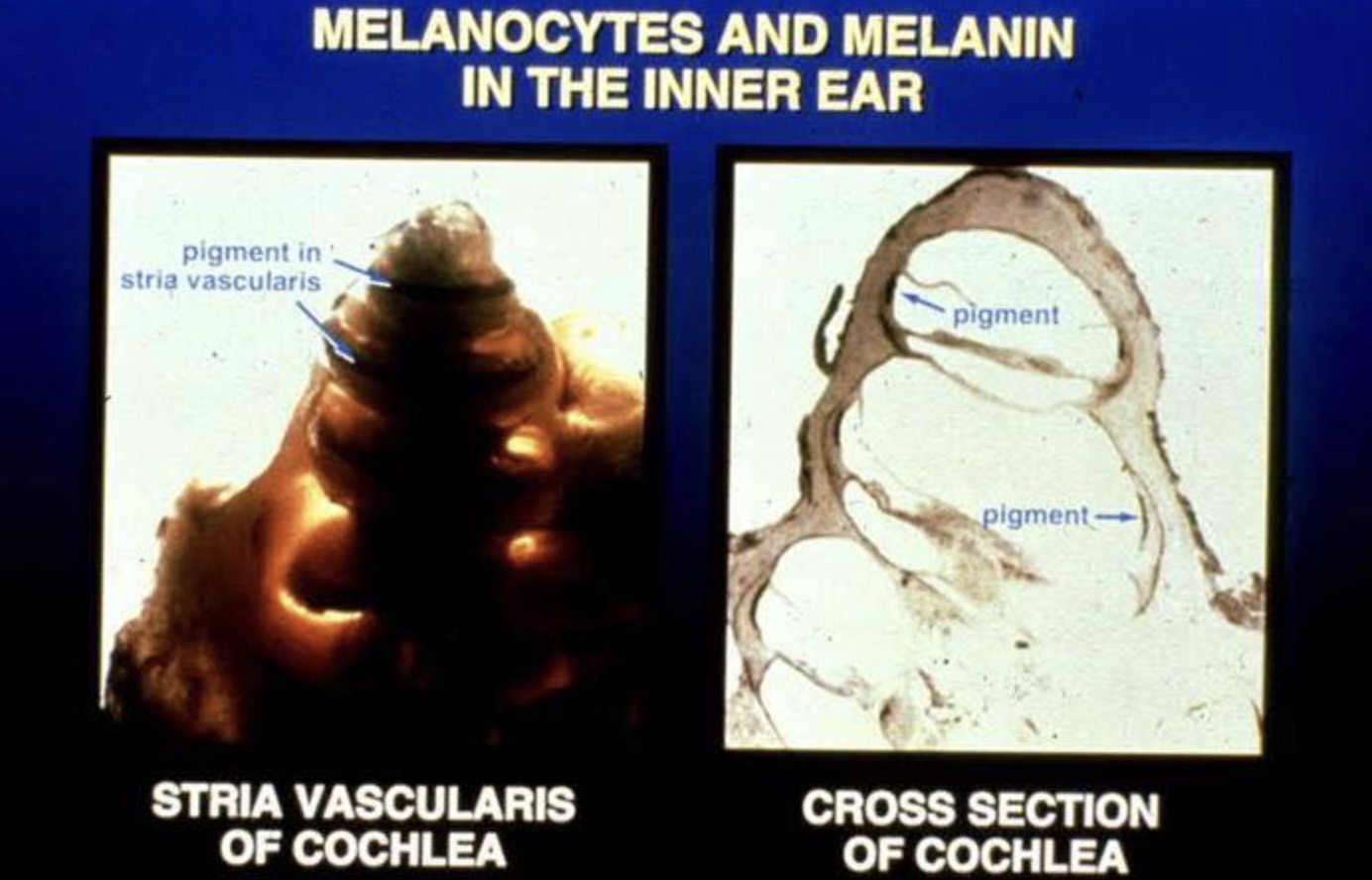
The presence of melanin in the inner ear was established more than a century ago, but the exact biological function of the pigment in the labyrinth has yet to be determined in medical textbooks. This is why tinnitus remains a mystery for docs and their patients afflicted with it.
Special attention should be drawn to the composition of melanin. Melanin is a biological reservoir for divalent ions like calcium and as an ion exchanger, as well as an intracellular buffering system for calcium. nnEMF alters the resonance frequency of this atom. nnEMF also alters voltage-gated channels that control calcium flow. This explains why melanin and nnEMF are likely linked to the symptom of tinnitus. It should be pointed out to the non learned that melanin is capable of binding ototoxic drugs. Finally, morphological responses of melanocytes happen when local disturbance of Ca++. Below you can see how calcium is quantized to the light that affects the afferent loop in this reflex.
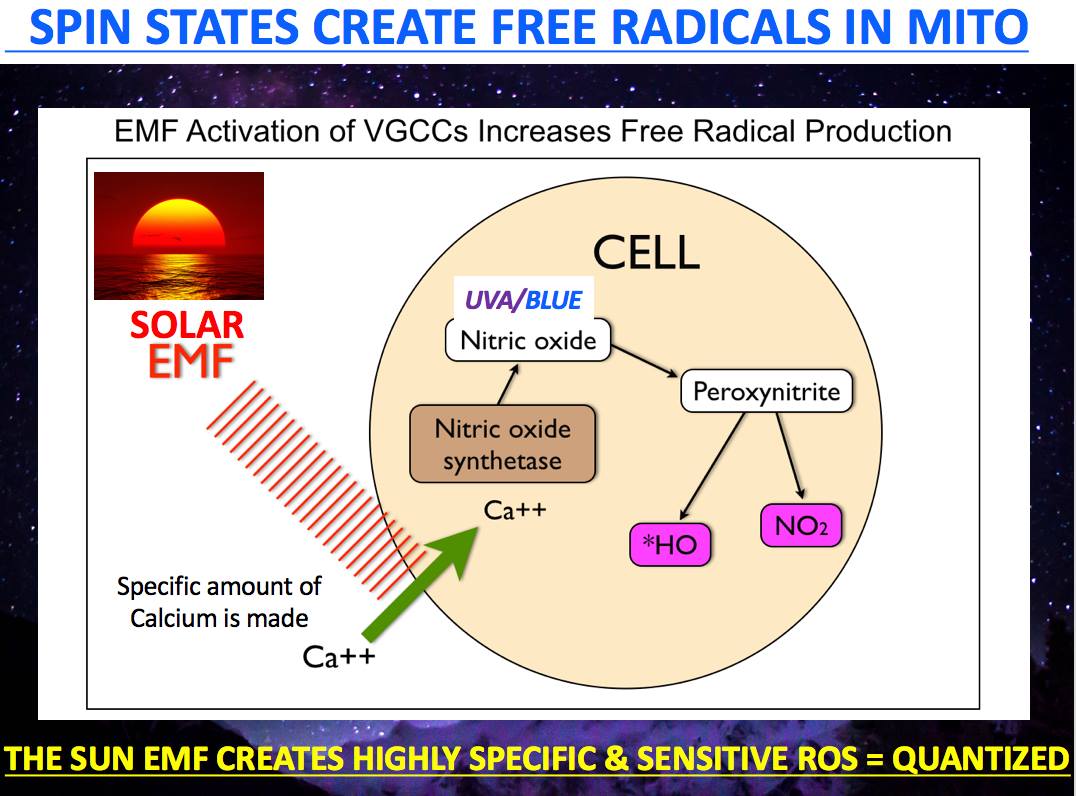
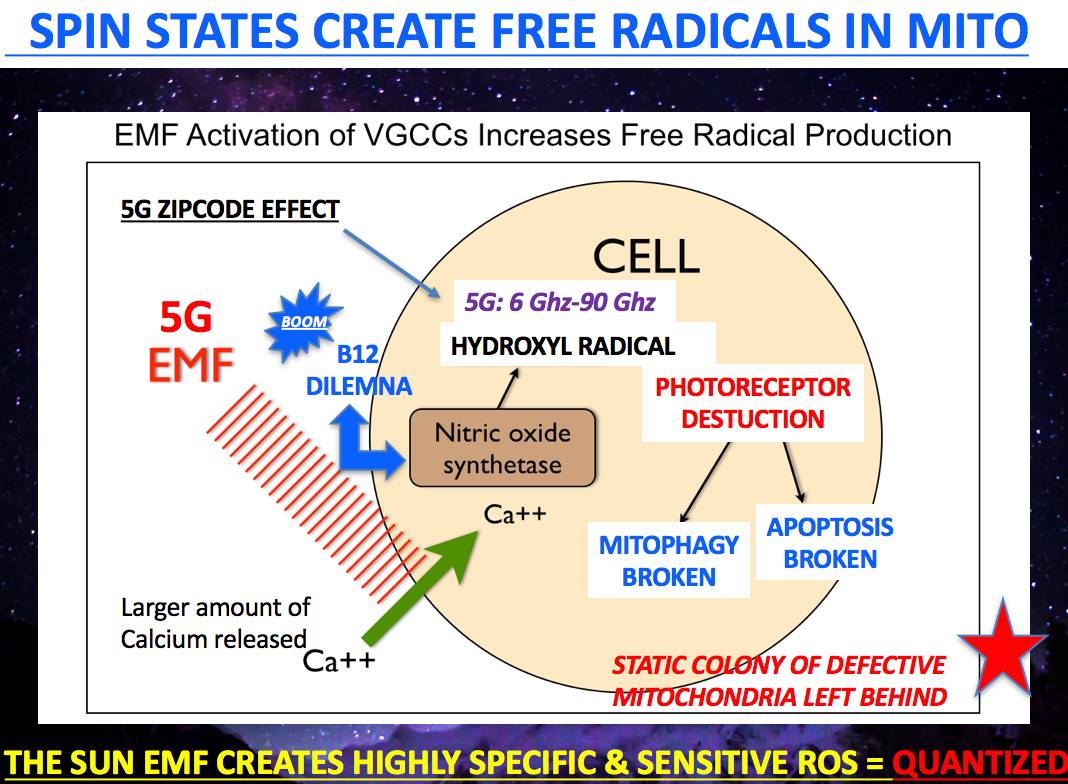
One last link of Ca2+ release to another ear disease is Meniere’s disease which is often linked to tinnitus. An altered level of melanin or an imbalance of its functioning can create an imbalanced Ca2+ homeostasis in the inner ear. This has been demonstrated using endolymphatic hydrops (EH) as an animal model for Meniere’s disease. These models have shown us that there is a possibility of a receptor-mediated Ca2+ transport across the pigmented epithelial layer, especially the light cells, and the presence of a ‘chemical signal’ as an initiating modulating factor in the disturbance of Ca2+ homeostasis. It appears light tunes the cochela using calcium as the electromechanical lever. It is pointed out numerous times in the PEER reviewed literature that melanin is capable of binding calcium and may act as a buffering system in hearing and in balance.
Quantum mechanics rarely extends to molecular medicine. Recently, the pigment melanin was found to be susceptible to chemiexcitation, in which an electron is chemically excited to a high-energy molecular orbital. In invertebrates, chemiexcitation causes bioluminescence; in mammals, a higher-energy process involving melanin transfers energy to RNA and DNA and mtDNA without using photons. This can create lethal and mutagenic cyclobutane pyrimidine dimers that can cause many diseases. This process is initiated by the free radicals NO and O2-. Their formation can be triggered by nnEMF light and/or inflammation. Several chronic diseases share two properties: inflammation generates these radicals across the tissue, and the diseased cells lie near melanin. I have said for 15 years that that nonquantized chemiexcitation may be an upstream event in numerous human diseases that lead to mitochondrial damage.
DNA AND mtDNA REPAIR IS NOT EQUIVALENT
Nuclear DNA repair of UV pyrimidine dimers in Chinese hamster ovary cells (CHO cells) is very selective with preferential repair of only sequences containing actively transcribed genomic regions. In essence, the literature over the last 30 years has shown very little repair mechanisms of these dimers in the entire mitochondrial genome of any animal tested. Nuclear DNA repair mechanisms are quite rapid and very accurate. Direct nuclear DNA action is likely not the mechanism that leads to disease. Research has shown, even actively transcribed areas in mtDNA do not appear to be repaired in mitochondrial DNA. This data is in agreement with that previously reported in HeLa cells and in yeast where a lack of repair of pyrimidine dimers in mitochondrial DNA was also observed.
The chemiexcitation path to diseases is a new quantum mechanical idea. It has long been known that photons of ultraviolet radiation from sunlight can be directly absorbed by DNA, where they excite DNA bases. If two excited pyrimidines (thymine or cytosine) are adjacent in RNA, DNA or mtDNA, a double bond forms automatically by the action of light. UV light can do this but it blue light is also quite capable of doing this as well. When blue light creates ROS and RNS it opens thymine or cytosine to form two single bonds between the bases and makes a cyclobutane pyrimidine dimer (CPD); this [2+2] cycloaddition reaction can only happen if the bases are in an excited state by light. Sunlight normally can lead to cell death via apoptosis. It can also stimulate NK cells to take out the altered cell filled with mitochondrial disease and viral loads. Alien light does not stimulate immunosurveillance in the same “quantized way” that sunlight does and this can lead to cancers or other mitochondrial disease. This is often associated with co-morbid hypoxia in the cell. Immunological surveillance is a monitoring process of the immune system to detect and destroy virally infected and neoplastically transformed cells in the body. This is why altered melanosis is linked to both viral illness and cancers.
The CPD disrupts base pairing and distorts the DNA helix, leading to cell death or – when DNA replicates – a C→T mutation. Mutations in oncogenes and tumor suppressor genes are required for disease generation like cancer. Chemiexcitation instead excites the DNA bases long after light exposure has ended because of how melanin operates with light. In this situation, light radiation serves to activate enzymes that synthesize the radicals NO• and O2•−for hours afterward. These radicals form peroxynitrite, which oxidizes melanin or its monomer DHICA (5,6-dihydroxyindole-2-carboxylic acid) and allows ambient O2 to create a dioxetane on the melanin. The dioextane moiety, is a strained 4-atom ring containing –C–O–O–C–, is unusual in being able to release large amounts of energy in a single reaction, creating long-lived, high-energy, electronically excited triplet states (denoted by * below).
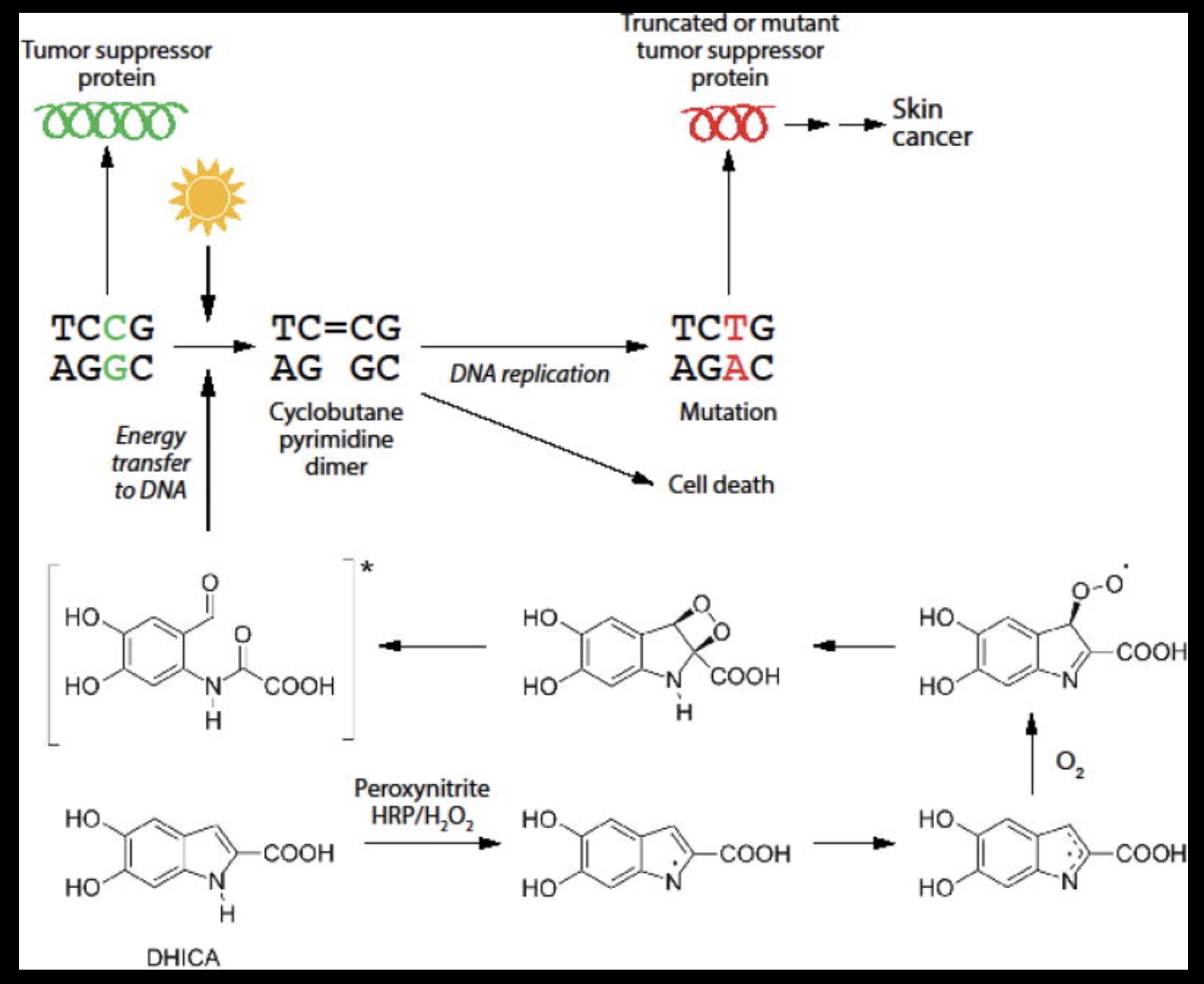
This triplet energy can transfer to RNA/DNA/mtDNA, resulting in a CPD without the involvement of photons. Thereafter, an unrepaired CPD would again result in mutations or cell death. The same radicals are formed during normal cellular inflammation from nnEMF damage, creates the same end product can be created by enzymes like horseradish peroxidase (HRP), prompting the idea that chemiexcitation can occur in internal organs leading to a myriad of diseases that today have no explanation of what causes them. This mechanism is likely why RF and microwave radiation damaged the ears and brains in people stationed in the Cuban embassy a couple of years ago when and Electromagnetic device was aimed at our emabassy to cause damage to US citizens.
Human mitochondria have their own DNA, which is double- stranded, circular and contains —16,569 base pairs. The mitochondrial genome has been sequenced in its entirety and consists of genes that code for 13 subunits of the respiratory chain complexes, 22 tRNAs and two rRNAs. Until recently, the only mitochondrial DNA defect that appeared to be of significance was that of a mutation in one of the mitochondrial ribosomal RNA genes which conferred chloramphenicol resistance. However, within the past 30 years defects in the mitochondrial genome have been described in a number of human diseases. The initial description by Holt et al. of deleted mitochondrial DNA in patients with mitochondrial diseases has been confirmed by numerous studies which found that mitochondrial deletions occurred in > 90 % of cases with Kearns—Sayre syndrome. Additionally, mitochondrial point mutations have been associated with Leber’s hereditary optic neuropathy, Pearson’s syndrome, autism, T2D, and some cases of chronic progressive external ophthalmoplegia. Accumulations of mutations in mitochondrial DNA have also been reported in the brains of patients with Parkinsonism and Alzheimers disease. These findings suggest that mitochondrial DNA defects are of biological importance in modern medicine. It makes you wonder why medicine keeps ignoring these links.
What does all this imply? If you live at a high latitude, with poor sunlight, have too much nnEMF in your life that causes hypoxia, or you live in a large city with many people addicted to technology, you are at risk for hearing loss and tinnitus. It also might be a precursor symptom to macula degeneration and neurodegeneration in the brain. Anywhere melanin is located, chemiexcitation can cause mtDNA damage and cause a hum in your ears.
CITES:
Chemical excitation of electrons: A dark path to melanoma.Premi S, Brash DE.DNA Repair (Amst). 2016 Aug;44:169-177. doi: 10.1016/j.dnarep.2016.05.023. Epub 2016 Jun 1.PMID: 27262612
- UV-induced Melanin Chemiexcitation: A New Mode of Melanoma Pathogenesis.Brash DE.Toxicol Pathol. 2016 Jun;44(4):552-4. doi: 10.1177/0192623316632072. Epub 2016 Mar 7.PMID: 26951162
- Role of Melanin Chemiexcitation in Melanoma Progression and Drug Resistance.Premi S.Front Oncol. 2020 Aug 6;10:1305. doi: 10.3389/fonc.2020.01305. eCollection 2020.PMID: 32850409
- Photochemistry. Chemiexcitation of melanin derivatives induces DNA photoproducts long after UV exposure.Premi S, Wallisch S, Mano CM, Weiner AB, Bacchiocchi A, Wakamatsu K, Bechara EJ, Halaban R, Douki T, Brash DE.Science. 2015 Feb 20;347(6224):842-7. doi: 10.1126/science.1256022.PMID: 25700512
- Unanticipated role of melanin in causing carcinogenic cyclobutane pyrimidine dimmers.Premi S, Brash DE.Mol Cell Oncol. 2015 Jun 23;3(1):e1033588. doi: 10.1080/23723556.2015.1033588. eCollection 2016 Jan.PMID: 27308551
